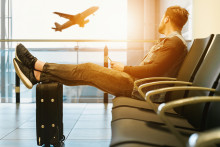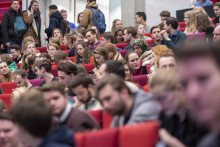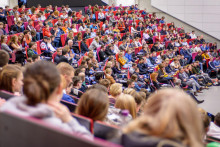What are the main causes for the chaotic situation at so many airports?
‘The biggest problem is undercapacity. At this point, we can come up with patches to cover the wound, but not completely solve the problem. There are simply too few employees trying to process too many passengers. And yet, we are still not at pre-COVID numbers of passengers. A lot of people were laid off during the pandemic and now it is hard to hire them back at a good pace. It is all going faster than anticipated. Schiphol made some estimates on how many people would be travelling, but the pandemic recovery is happening faster than in their fastest scenario.’
It is not specific to the Netherlands. How come this is happening all over?
‘The causes are similar across Europe. It’s all due to understaffing. Mostly there aren’t enough security officers and ground handlers. Both of these services are not provided directly by Schiphol airport, these people are employed by private companies. And these companies were already struggling with personnel before COVID. Currently, every company is struggling to find staff and these are jobs that are relatively low paid and have very irregular working hours. The situation is very similar for security personnel, which is also hired by a private company. This isn’t the case at all airports, however. In some countries, the security is handled by police which might be less susceptible to workforce fluctuations than private companies.’
Dennis Prak
Dennis Prak is an assistant professor in the department Industrial Engineering and Business Information Systems at the University of Twente. Dennis' main research interests are in data-driven optimization, aviation, and logistics on a broad definition. He coordinates and teaches in the Minor Aerospace Management & Operations.
Dennis Prak. Photo by: Patricia Rogetzer
Could this have been prevented?
‘What is interesting: given that you are low on capacity, other issues start accelerating each other. You are low on capacity, the queues become longer. The passengers become aware of that, they start coming early and queues get even longer. We can’t currently change the problem of capacity, but we could potentially find a way to have people waiting in the queues in the right order. For example, if your flight leaves in two hours, you should go before a person whose flight leaves in three hours. But that is very difficult to arrange in the chaotic circumstances that we currently face.
In the long run, airports aim to process data in real time using prediction models to customize the passenger experience, tailoring the products and services offered to them. They’d like to steer the passenger journey and thereby generate more revenue. In these extreme cases, similar technology could assist in smoothly guiding passengers through security, utilizing available capacity as smartly as possible.’
Is there anything scientists can do to help at this point?
‘During the pandemic, science has learnt how to better organize people flows and queues. For example, vaccination centers needed to get a different layout than originally thought. The first ones didn’t offer enough overview, people couldn’t see where to go, what was coming next. People need to be able to form a mental image of where to go. There is a similar problem at airports. Many airports are an architectural marvel. They are beautiful buildings with a lot of nice design and things trying to grab your attention. But this can lead to a sensory overload. People can’t easily see where to go, which becomes even worse if terminals are already crowded. Improving this could be another patch on the wound.
There are also some technological improvements that could be made. At the moment, security screening is very labor intensive. There are several officers involved per each passenger. As AI developments become more advanced, in the future it becomes possible to have a single officer supervising multiple security lanes, just like already now a single customs officer is supervising multiple automated passport check lanes. The full body scanners, for instance, already use image recognition techniques to detect where a passenger may be hiding something suspicious, so that the officer knows where to search.’
Besides cancelled flights and unpleasant travel experiences, what are the dangers of this situation?
‘Airports systems are designed so that - under normal circumstances – you are a bit early and spend time and money after going through security. There are more studies related to this than you’d think. For example, if you exit security, duty-free shops are often positioned such that most products are on your right-hand side - because most people are righthanded and therefore more likely to look that way. But now the airport’s own business model is working against them. People come very early, but just end up waiting in long lines.
There is also a safety aspect to this problem. Airport security has severely tightened over the years to prevent terrorist attacks. However, when big crowds form on the public side of the airport, they can actually become a target, reachable without having to pass through security.’
Are there any solutions that could at least improve the situation? Such as logistical improvements or better management?
‘Airport and airline management is very complex. For example, Schiphol is a hub airport. That means, airlines – such as KLM – use Schiphol to let passengers connect between short- and long-haul flights. Traffic therefore moves in waves, because the flights connect to each other. There are peak times, but in between those times there is a lot less to do. Some airlines worldwide have experimented with spreading the flights across the whole day, but that often came at a too severe loss of good connections. The airports could, for instance, charge higher fees for the peak times and stimulate the airlines that way, but that also often didn’t work out well in the past. It was too complicated for airlines to change their entire operation based on one airport’s rules. On top of that, it is not the airport – or the airlines – who decides who is allowed to fly when. That is up to an independent slot coordinator, who tries to keep the process fair. As you can see, there are just so many links, this problem is very difficult to solve.’
Do you have any tips for the airports, the airlines, and regular passengers?
‘For airports it’s just necessary to find more staff as quickly as possible. Otherwise, in the short run, they cannot do much other than limiting the number of passengers in order to fight the queues, as Schiphol currently does. Regional airports would be happy to accommodate some flights from Schiphol but that decision is up to the airlines. Using some regional airports would be the perfect solution, because Groningen and Maastricht, for example, have some free capacity. To the passengers, I’d say: consider taking the train as an alternative to short flights. If you really need to go to an airport, then you face a tricky trade-off: If you want to optimize the situation for yourself, you go early. But if you want to optimize it for everyone, you come on time and double check that your pockets are empty when you pass through security.’








